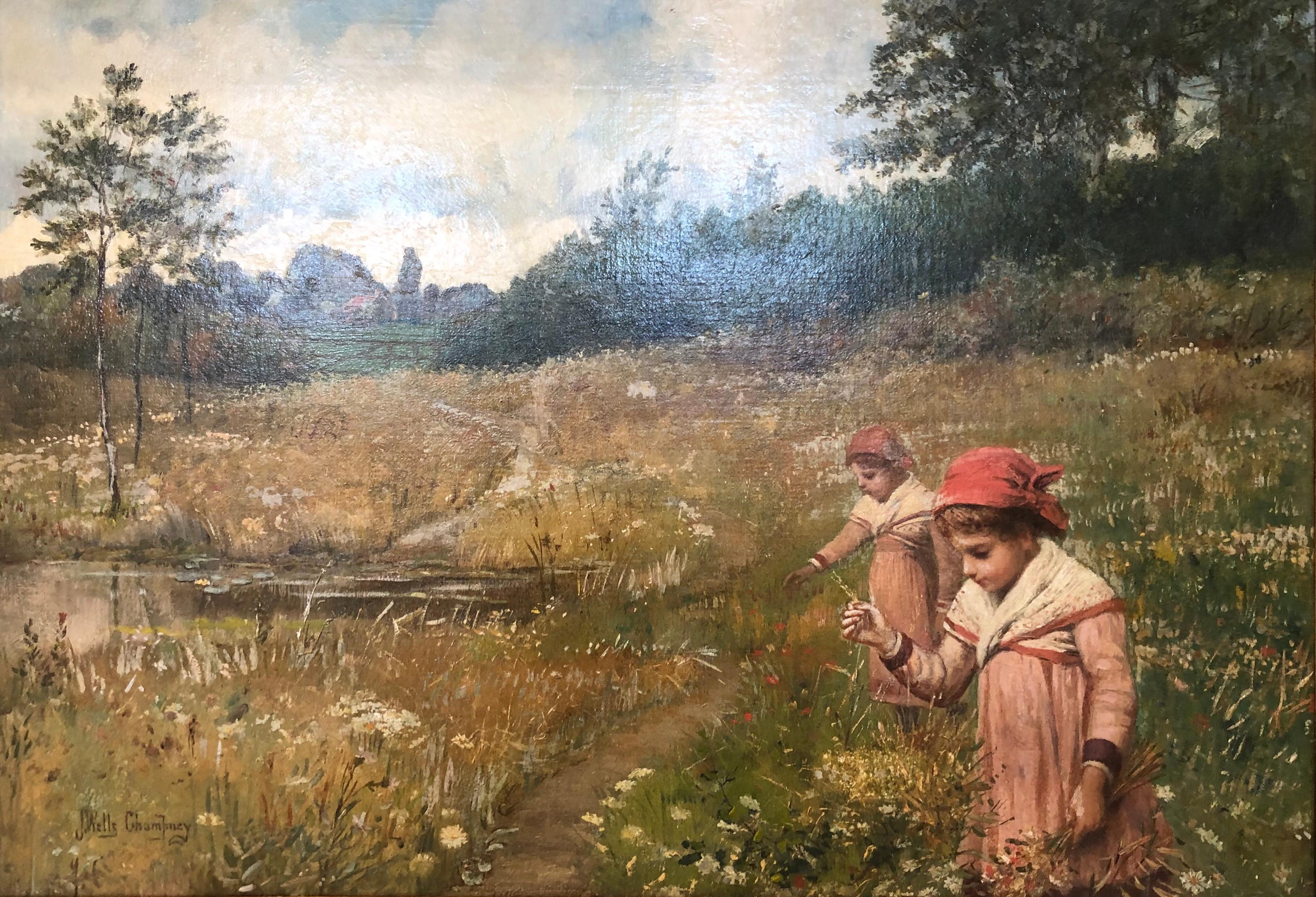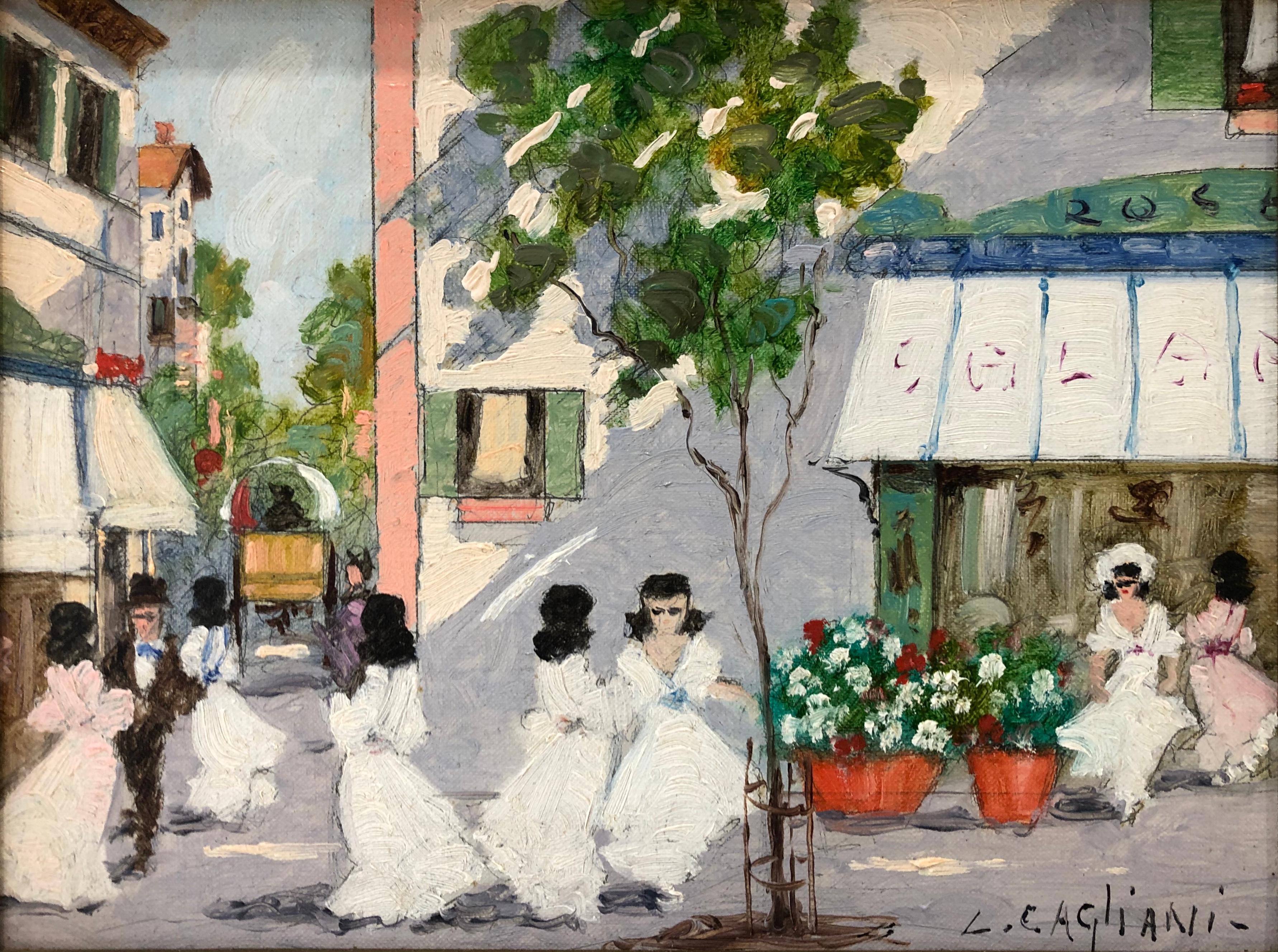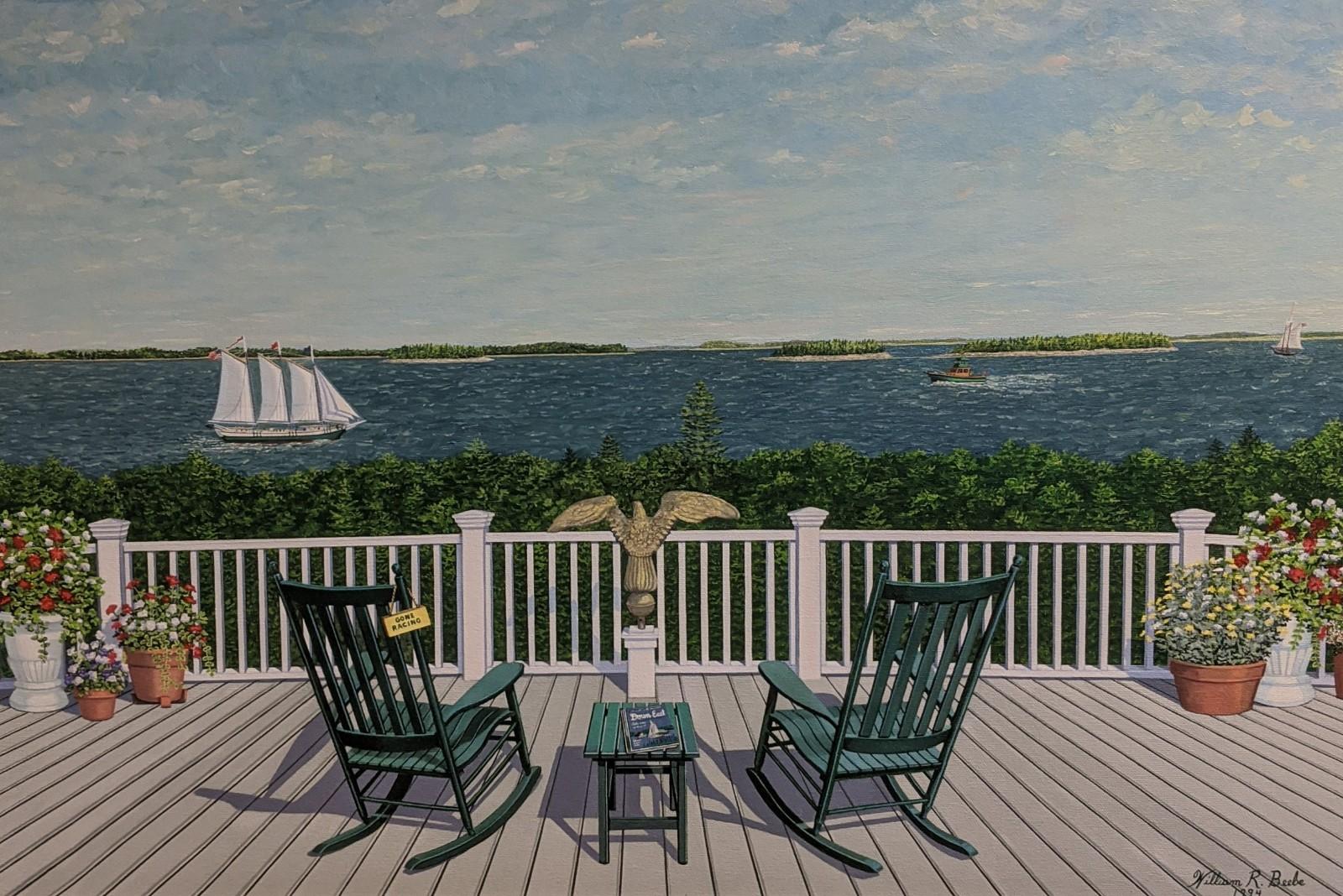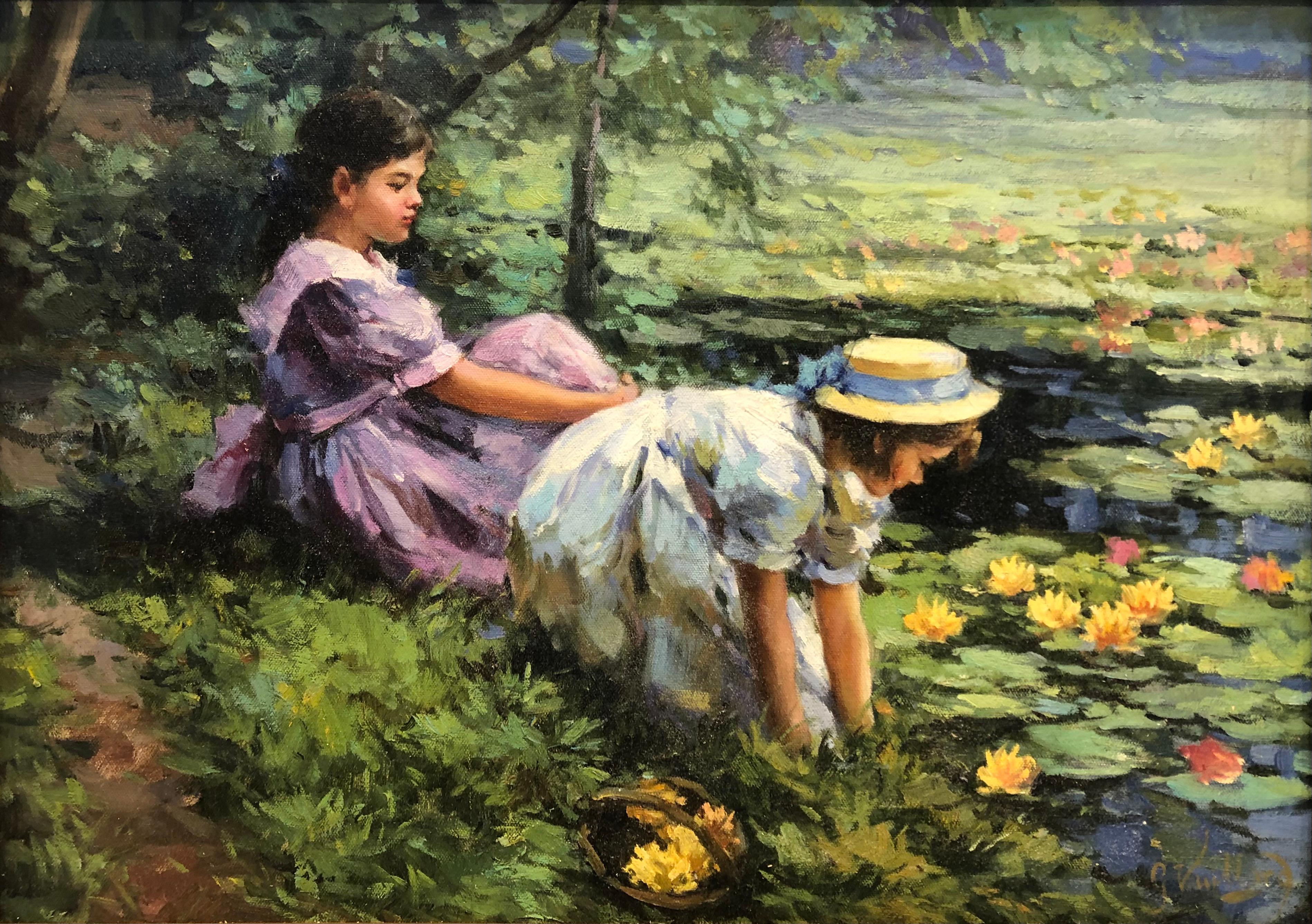Items Similar to The Golf Links
Want more images or videos?
Request additional images or videos from the seller
1 of 9
Childe HassamThe Golf LinksDated 1926
Dated 1926
About the Item
Childe Hassam
1859-1935 American
The Golf Links
Oil on canvas board
Signed, located and dated "Childe Hassam / Easthampton / Oct 7th 1926" (lower right)
Widely regarded as the foremost American Impressionist painter, the incomparable Childe Hassam captures the calm tranquility of the golf course in this extraordinary oil on canvas laid down on board, complete with the original frame designed by Hassam himself. The work is representative of the artist’s enduring attachment to East Hampton, a picturesque village in Long Island, New York. His fascination led him to spend most summers in the seaside town during the last two decades of his life — it was during one of these visits in 1926 that he composed the present scene. The idyllic village, with its meadows, gardens, beaches and grand old houses, inspired some of the best works of the artist’s oeuvre, and the best years of his life. As an obituary stated, “He lived with gusto, smoked a pipe, played golf, kept a good cellar, buffeted the East Hampton surf with a great, bronzed body, and worked joyously until his last illness.”
With an impressionistic eye, Hassam captures here the nuances of color and light on the “green” with an array of hues — greens, blues, yellows and purples all form the expanse. The cool-toned tranquility of the course is echoed in Hassam’s exquisitely rendered sky. Soft, cotton-like clouds hover above the indistinct horizon line; their blue-grey tones and rolling brushstrokes give the pictorial sky a shimmer of movement. He weaves together different textures and tones in a single, bold brushstroke, creating a scene that is cohesive yet ethereal. The subject of this work is the Maidstone Club, an exclusive private club in East Hampton, New York, established in 1891.
A pioneer of American Impressionism, Hassam’s distinctly American subjects are both nostalgic and vibrant, and today are considered among the best of turn-of-the-century American art. Born in Dorchester, Massachusetts, Hassam began his artistic career as a freelance illustrator, working for nationwide publications such as Harper’s Weekly, Scribner’s Monthly, and The Century. His first solo exhibition of watercolors took place in Boston in 1883, and he quickly catapulted onto the international scene, winning a bronze medal at the Exposition Universelle in Paris in 1889. Upon his return from Paris, his work took on the distinctly impressionistic style for which he is today so beloved. A true master, Hassam depicted a way of life characteristic of both American and French society, and his work elucidates an important chapter in American history. Today, his work resides in numerous important museums, including the Metropolitan Museum of Art in New York, the National Gallery of Art in Washington, DC and the Museum of Fine Arts in Boston, among others.
This painting will be included in Stuart P. Feld's and Kathleen M. Burnside's forthcoming catalogue raisonné of the artist's work.
Dated 1926
Panel: 10 3/8” high x 12 5/8” wide
Frame: 16 3/4” high x 19 1/4” wide
Provenance:
Senator William Benton, Southport, Connecticut
Thence by descent in the family
Private Collection
References:
Childe Hassam, American Impressionist, 2004, by H.B. Weinberg and E. Barker
- Creator:Childe Hassam (1859-1935, American)
- Creation Year:Dated 1926
- Dimensions:Height: 16.75 in (42.55 cm)Width: 19.25 in (48.9 cm)
- Medium:
- Movement & Style:
- Period:
- Condition:
- Gallery Location:New Orleans, LA
- Reference Number:
About the Seller
5.0
Vetted Seller
These experienced sellers undergo a comprehensive evaluation by our team of in-house experts.
Established in 1912
1stDibs seller since 2013
13 sales on 1stDibs
Typical response time: 4 hours
- ShippingRetrieving quote...Ships From: New Orleans, LA
- Return PolicyThis item cannot be returned.
More From This SellerView All
- Au Bord De La Rivière By Pierre-Auguste RenoirBy Pierre-Auguste RenoirLocated in New Orleans, LAPierre-Auguste Renoir 1841-1919 French Au bord de la rivière (Along the River) Oil on canvas "Renoir may be the only great painter who has never painted a sad picture." - Octave ...Category
19th Century Impressionist Landscape Paintings
MaterialsOil, Canvas
- Barque De Peche En Mer By Henry MoretBy Henry MoretLocated in New Orleans, LAHenry Moret 1856-1913 French Barque de Peche en Mer Fishing Boat at Sea Signed and dated “Henry Moret 1912” (lower left) Oil on canvas A beautiful gestural composition imbued with the sublime beauty of the open sea, this oil on canvas by Impressionist Henry Moret showcases the artist's deft use of color and texture. One of the most celebrated painters of the Pont-Aven School, Moret’s lasting reputation is tied to his talent for capturing the bright skies, lively waterways and the diverse coastline of northern France. With a mastery of plein air composition and a deep appreciation for the natural world, Moret's Barque de Peche en Mer renders a fishing boat navigating through the ocean. Moret creates a visceral sense of the vitality of the water and the enormity of the open skies. The artist captures the vigorous energy of the sea with a profusion of green and blue hues applied with a thick impasto. Small yet mighty against the infinite backdrop, Moret's fishing boat forges ahead. Henry Moret was born in Cherbourg in 1856, though little else is known about his early life. He entered military service as a young man in 1875, and it was during that period when Moret discovered the beauty of France’s northern coasts, particularly those of Normandy and Brittany. After his tour ended, he embarked on his artistic career, completing his formal education at the École Nationale des Beaux-Arts under Jean-Leon Gérôme, and later, from about 1880, under Jean-Paul Laurens at the Académie Julian. He exhibited for the first time at the Paris Salon in 1880, submitting a landscape of the coast of Brittany. During his time in Paris, he frequently traveled to Brittany to paint the region he so loved. In 1888, he more firmly established himself in Pont-Aven, a town whose center had become an artistic refuge for artists such as the great Paul Gauguin, Ernest Ponthier de Chamaillard, Emile Jourdan and others. Under Gauguin's influence, he briefly explored the concept of Symbolism in his works, but after Gauguin left Pont-Aven in 1891, Moret returned to his Impressionist roots. He formed a relationship with the famed dealer Durand-Ruel in 1895, and his career was officially launched. Today, his works can be found in important museums including the Manchester Art Gallery, the State Hermitage Museum (St. Petersburg), the National Gallery of Art (Washington DC) and others. Dated 1912 Canvas: 28 3/4” high x 36 3/4” wide Frame: 36 5/8" high x 44 1/8" wide Exhibited:Henry Moret, Galerie Durand-Ruel, April 5-January 29, 1966, n° 47 Provenance: Sale Marcel Bernheim...Category
20th Century Impressionist Landscape Paintings
MaterialsOil, Canvas
- The Bather by Childe HassamBy Childe HassamLocated in New Orleans, LAChilde Hassam 1859-1935 American The Bather Signed and dated “Childe Hassam” (lower right) Oil on canvas Considered by many to be America’s foremost Impressionist painter, Childe Hassam composed his tranquil and intimate oil on canvas The Bather in the early years of the 20th century. The creation of the artwork aligns with a period of Hassam’s career where the artist’s palette was transforming, matching ever closer with the pale and pastel hues of French Impressionists like Claude Monet. Even the subject — a nude woman — represents a greater alignment with the Impressionist project, as artists of the movement and their non-mythological and non-biblical nudes still generated cries of indecency. With Hassam’s signature brushwork and attention to color, The Bather serves as a dream-like vision, serene and sensuous, of a young woman bathing in a lush forest. While the artist's skill for landscape painting is on display, it is Hassam's command of form, light and color that brings this canvas to life. He creates a captivating composition, placing the nude subject in the bottom left of the canvas. The soft, undulating curves of the woman's body in contrapposto and the glow of her fair skin are balanced by the strong verticals and deep earth tones of the tall trees to her right. Hassam delicately frames the nude in the vivid blues of the distant water, building luminous color that further draws the viewer’s eye and results in a somewhat voyeuristic appeal — endowing his nude with both a natural innocence and an intentional sensuality. Born in Dorchester, Massachusetts, Childe Hassam began his artistic career as a freelance illustrator, working for national publications such as Harper’s Weekly, Scribner’s Monthly, and The Century. His first solo exhibition of watercolors took place in Boston in 1883, and he quickly catapulted onto the international scene, winning a bronze medal at the Exposition Universelle in Paris in 1889. The year before the present work was created, he received the Webb Prize from the Society of American Artists for another landscape painted at Gloucester. Hassam would receive numerous other awards throughout his career, most notably the Gold Medal for Distinguished Services to Fine Art from the American Dealers Association. A true master, Hassam depicted a way of life characteristic of both American and French society, and his work elucidates a critical chapter in American art history. Today, his work resides in the Oval Office of the White House and in numerous important museums, including the Metropolitan Museum of Art in New York, the National Gallery of Art in Washington, DC and the Museum of Fine Arts in Boston, among others. This painting will be included in Stuart P. Feld's and Kathleen M. Burnside's forthcoming catalogue raisonné of the artist's work. Circa 1905 Canvas: 24 1/2“ high x 20 18” wide Frame: 35 7/8“ high x 31 1/4” wide x 3 1/4“ deep Provenance: Private Collection of William Young...Category
20th Century Impressionist Nude Paintings
MaterialsOil, Canvas
- Dans le parc en automne, Paris (In the Park in Autumn, Paris)By Jean Francois RaffaëlliLocated in New Orleans, LAThis thoroughly modern Parisian scene was composed by the celebrated French painter Jean François Raffaëlli. The delicate oil captures a familiar subject from late 19th-century life in the city: a busy avenue at the edge of a park on a cool autumn day. Exploring the climate of the city, Raffaëlli's mature works capture the energy of the grand parks and boulevards of the new Paris that emerged at the turn of the century. His legacy documents the realities of urban life during his age, all chronicled in his distinctive brushwork and sophisticated palette. While Raffaëlli was never fully accepted as a member of the Impressionist group, his works display a similar affinity for capturing the transient moments of modern life. His figures exude a sense of being suspended in time, as though they are part of some subtle narrative that is both restless and harmonious. Perhaps more aligned with Naturalism than Impressionism, the visual effect of Raffaëlli's composition is one of carefully composed spontaneity that makes manifest the joie de vivre of the age. Raffaëlli was not the only artist of his era to devote his canvases to the urban landscape. Camille Pissarro, Claude Monet, Gustave Caillebotte and others composed significant works on the subject of the urban milieu. On the whole, it was an entirely new kind of painting, and it was largely influenced by the work of social engineer Baron Haussmann beginning in the 1850s. At the request of Emperor Napoleon III, Haussmann designed and carried out a large-scale urban renewal program, erecting landmarks and tree-lined thoroughfares throughout the city to create a unified and socially-centered urban aesthetic. The city became a glittering stage for modern advancements and bourgeois pleasure, which paved the way for a new kind of subject that was eagerly adopted by the Impressionists and artistic avant-garde. Born in Paris in 1850, Raffaëlli first studied theater and music before turning to painting in 1870. That same year, he submitted a landscape painting to the Salon and was accepted. Aside from just three months studying with the Academic great Jean-Léon Gérôme, Raffaëlli was self-trained, developing his own unique style that brought together Realism, Naturalism and Impressionism. While he managed to exhibit works at both the Salon and the Impressionist exhibitions...Category
Late 19th Century Impressionist Landscape Paintings
MaterialsBoard, Oil
- L’embarquement by Gaston La ToucheBy Gaston La ToucheLocated in New Orleans, LAGaston La Touche 1854 - 1913 French L’embarquement The Embarkment Signed "Gaston La Touche" (lower right) Oil on panel A fashionable group of merrymakers boards a rowboat at sundown in this oil on panel by renowned French painter Gaston La Touche. Softly lit and lushly detailed, the work represents the artist’s talent for capturing the gaiety of the Belle Époque. With its luminous coloring and feathery brushwork, this oil evokes the style and joie de vivre of the era rendered in La Touche’s distinctive, mature style. Fresh and airy, the work is a beautiful example of the artist’s skill at capturing the subtle qualities of light and color. Set against the plein air backdrop of a wooded pond awash in the soft glow of the golden hour, the scene reflects the influence of the Impressionists. The subject also recalls works by Manet, Monet and Renoir, who delighted in depictions of modern leisure among the expanding middle class. The scene is an informal one, and its unconventional cropping suggests that the viewer is invited to take a seat in the boat and join the group on their outing. Such relaxed, inviting scenes were remarkably popular among contemporary, modern audiences. However, La Touche's style is singular, possessing an element of fantasy and romance that set him apart from the Impressionists. Gaston La Touche was born in St. Cloud, outside of Paris, in 1854, and he showed a keen interest in art from a young age. At ten years old, he began taking private art instruction, which lasted until 1870, when his family was forced to flee to Normandy amid the Franco-Prussian War. This was the only formal art training La Touche would ever receive. Despite his lack of Academy training, he made his debut at the Paris Salon of 1875 with a sculptural medallion and etchings, and he exhibited his first painting at the Salon of 1881. Although he began his career painting dark-toned realist compositions, by 1890, his style had shifted to what would become his signature — a lighter, brighter, idealistic society world. The artist was associated with practically all of the most influential artists and thinkers of late 19th century France, including Édouard Manet, Edgar Degas, Émile Zola, who frequently met at the legendary Cafe de la Nouvelle Athenes to share their thoughts on modern society. In 1900, he was named a Chevalier of the Legion d'Honneur and an Officer in 1909. Additionally, he was well-decorated at the grand...Category
Late 19th Century Impressionist Figurative Paintings
MaterialsPanel, Oil
- TaroudantLocated in New Orleans, LASigned, inscribed and dated "R. Pinatel / Taroudant / 1926" (lower right) Oil on panel A stunning ode to the Moroccan landscape, this oil on panel was composed by the French Orientalist painter Raphaël Pinatel, whose lively works adeptly translated the romanticism of the East for a Western audience. The present work, which captures a market in Taroudant, a city in southeastern Morocco, exemplifies the artist’s distinctive approach as he brilliantly translates the energy and atmosphere of the desert city. Pinatel’s style is impressionistic in his brushwork and handling of light and atmosphere. In the present work, he brilliantly captures the effects of the direct desert sun...Category
Early 20th Century Impressionist Landscape Paintings
MaterialsPanel, Oil
You May Also Like
- Venice Landscape Italian Oil on Canvas Painting in Gilt Wood Frame, Belle EpoqueLocated in Firenze, ITThis delightful turn of the century (early 20th century) oil on canvas painting represents an Italian landscape with one of the most famous squares in the world: Piazza San Marco in ...Category
Early 20th Century Impressionist Landscape Paintings
MaterialsCanvas, Oil
- Houses And River-Large Impressionist Landscape Oil on Canvas Signed A.HuntingtonLocated in Coimbra, PT"Houses And River" Signed A. Huntington (English School) Oil on canvas Measures: Canvas - 60x110 cm (Gilt Wood Frame - 76x126 cm) Private collection. FramedCategory
Early 20th Century Impressionist Landscape Paintings
MaterialsCanvas, Oil
- The Twins in the FieldBy James Wells ChampneyLocated in Greenville, DEExcellent example of the artist's work. Overall condition good. Early lining is also good. The sky was possibly repainted (probably by Champney 100+ years ago). Period frame 26 1/2in...Category
Late 19th Century Impressionist Landscape Paintings
MaterialsCanvas, Oil
- Deck of FoxhillLocated in Greenville, DEMarine scene from the deck of a Maine estate (Foxhill). William Beebe considers himself a Creative Realist, using touches of impressionism to go beyond representation. This particula...Category
20th Century American Impressionist Landscape Paintings
MaterialsOil, Canvas
- The Lily PondBy George VuillardLocated in Greenville, DEImpressionist painting by French artist George Vuillard in excellent condition. Painting is on canvas that has been mounted on wood panel. Approx 26 x ...Category
Late 20th Century Impressionist Landscape Paintings
MaterialsCanvas, Oil
- Boulevard de la MadeleineLocated in Greenville, DEExcellent example of Cortes Paris scene.Category
Early 20th Century Impressionist Landscape Paintings
MaterialsCanvas, Oil





